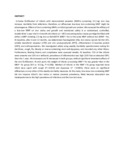| dc.contributor.author | Barth‐Jaeggi, T | |
| dc.contributor.author | Moretti, D | |
| dc.contributor.author | Kvalsvig, J | |
| dc.contributor.author | Holding, P A | |
| dc.contributor.author | Njenga, J | |
| dc.contributor.author | Mwangi, A | |
| dc.contributor.author | Zimmermann, M B | |
| dc.date.accessioned | 2014-12-16T08:59:05Z | |
| dc.date.available | 2014-12-16T08:59:05Z | |
| dc.date.issued | 2014-11-24 | |
| dc.identifier.citation | Barth‐Jaeggi, T., Moretti, D., Kvalsvig, J., Holding, P. A., Njenga, J., Mwangi, A., ... & Zimmermann, M. B. (2014). In‐home fortification with 2.5 mg iron as NaFeEDTA does not reduce anaemia but increases weight gain: a randomised controlled trial in Kenyan infants. Maternal & child nutrition. | en_US |
| dc.identifier.uri | http://onlinelibrary.wiley.com/doi/10.1111/mcn.12163/abstract? | |
| dc.identifier.uri | http://hdl.handle.net/11295/77680 | |
| dc.description.abstract | In-home fortification of infants with micronutrient powders (MNPs) containing 12.5 mg iron may increase morbidity from infections; therefore, an efficacious low-dose iron-containing MNP might be advantageous. Effects of iron-containing MNPs on infant growth are unclear. We assessed the efficacy of a low-iron MNP on iron status and growth and monitored safety in a randomised, controlled, double-blind 1-year trial in 6-month-old infants (n = 287) consuming daily a maize porridge fortified with either a MNP including 2.5 mg iron as NaFeEDTA (MNP + Fe) or the same MNP without iron (MNP − Fe). At baseline, after 6 and 12 months, we determined haemoglobin (Hb), iron status [serum ferritin (SF), soluble transferrin receptor (sTfR) and zinc protoporphyrin (ZPP)], inflammation [C-reactive protein (CRP)] and anthropometrics. We investigated safety using weekly morbidity questionnaires asking for diarrhoea, cough, flu, bloody or mucus-containing stool and dyspnoea, and recorded any other illness. Furthermore, feeding history and compliance were assessed weekly. At baseline, 71% of the infants were anaemic and 22% iron deficient; prevalence of inflammation was high (31% had an elevated CRP). Over the 1 year, Hb increased and SF decreased in both groups, without significant treatment effects of the iron fortification. At end point, the weight of infants consuming MNP + Fe was greater than in the MNP − Fe group (9.9 vs. 9.5 kg, P = 0.038). Mothers of infants in the MNP + Fe group reported more infant days spent with cough (P = 0.003) and dyspnoea (P = 0.0002); there were no significant differences on any other of the weekly morbidity measures. In this study, low-dose iron-containing MNP did not improve infant's iron status or reduce anaemia prevalence, likely because absorption was inadequate due to the high prevalence of infections and the low-iron dose. | en_US |
| dc.language.iso | en | en_US |
| dc.publisher | University of Nairobi | en_US |
| dc.title | In‐home fortification with 2.5 mg iron as NaFeEDTA does not reduce anaemia but increases weight gain: a randomised controlled trial in Kenyan infants. | en_US |
| dc.type | Article | en_US |
| dc.type.material | en | en_US |

